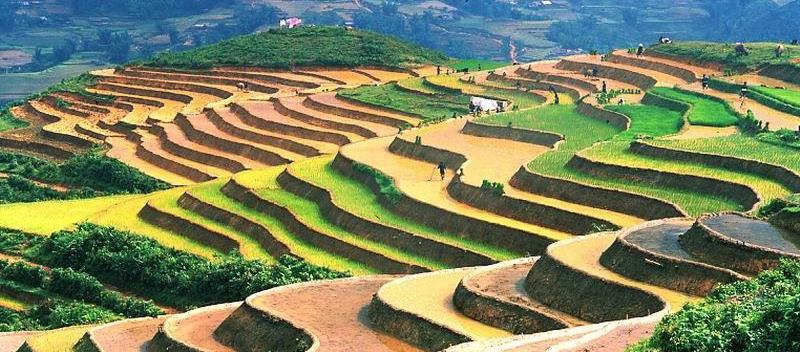
Despite its
commercialization during the last seven years, Sapa is still a must-see on any
northern Vietnam
itinerary. On a clear day you will treated to views of steeply terraced rice
fields, towering verdant ridgelines, primitive mud-thatched villages, raging
rivers and astounding waterfalls.
Nestled high in the
Tonkinese Alps near the Chinese border, Sapa was built as a hill station during
French colonial days, to serve as a respite from stifling Hanoi summers. These days, weekends are still
the biggest draw in this crumbling hill-tribe center. Visitors from the capital
flock to Sapa for a trek to local hill tribe villages, or an ascent of Vietnam's
highest peak, Fansipan.
Some eight ethnic
groups inhabit Lao Cai province: Hmong, Dao, White Thai, Giay, Tay, Muong, Hao and Xa Pho. The most prominent in town
are the Red Dao, easily identified by the coin-dangling red headdresses and
intricately embroidered waistcoats worn by the women
and the Hmong,
distinguished by their somewhat less elaborately embroidered royal blue attire.
Groups of ethnic Hmong youngsters and women can be seen hauling impossibly
heavy, awkward baskets of wood, stakes, bamboo, bricks, mud and produce.
Deep
in the valleys surrounding Sapa, the Muong
Hoa River
sluices a wild, jagged course among Giay, Red Dao and White Thai settlements,
their tiny dwellings poking out of the neon rice fields like diamonds on a
putting green. One- to four-day treks are offered by a handful of outfitters.
Guests sleep in tents or in the homes of villagers, their gear hauled by Hmong
porters.
Topping out at 3,143
meters, Fansipan has become the Mount Everest of Vietnam, with queues of
yuppie trekkers in their latest Travel Smith "totally-pack able"
rainwear forming mountaineering traffic jams at base camps.
Way to the top of Fansipan mountain
Sapa itself is a
somewhat bedraggled village meshing crumbling, mildewed French colonial
architecture with the pencil-thin, brick-and-concrete mini-hotels that have
become so ubiquitous in recent years all across Vietnam. This neglected, cultural
mishmash would be an eyesore in any place less spectacularly scenic than Sapa.
Because of its Shangri-la-like setting, Sapa actually seems quaint – a
tranquil, restful village. Which is, of course, what the French originally
intended the place to be. Amenities are limited unless you choose to stay at
the Four Star Victoria Sapa, a sprawling alpine campus nestled discreetly into
a hillside in the center of town.
The best times of the
year to visit Sapa are in the spring and fall. Summers tend to be rainy and
muddy, while winter temperatures can drop to the freezing mark (Sapa ushered in
2000 with snow!). Weather really does make a difference here, because the
spectacular scenery is all but blotted out when there is cloud cover and rain.
Ignore the other Nikon-toting tourists in the villages and get out into the
countryside, where you just may still catch a glimpse into hill-tribe life of a
couple of centuries ago.